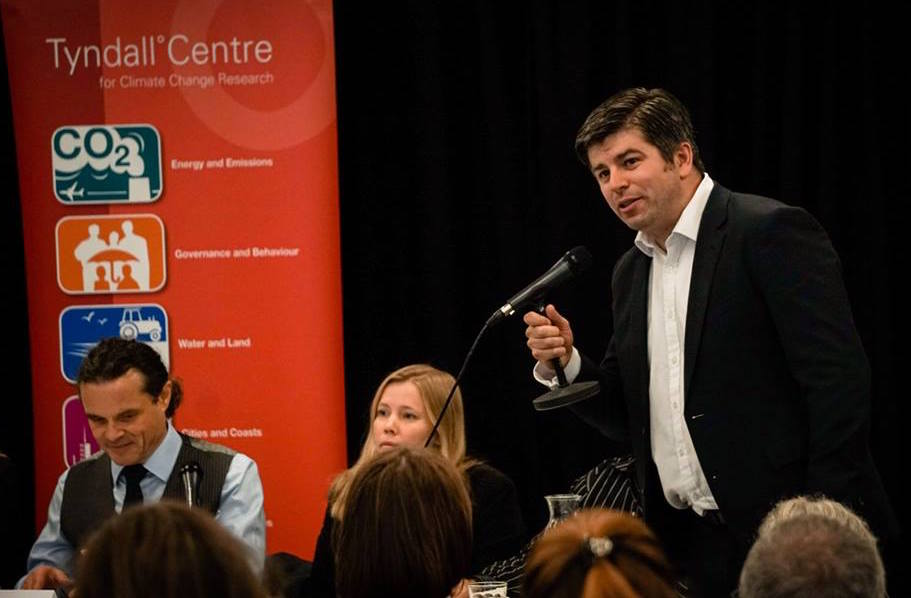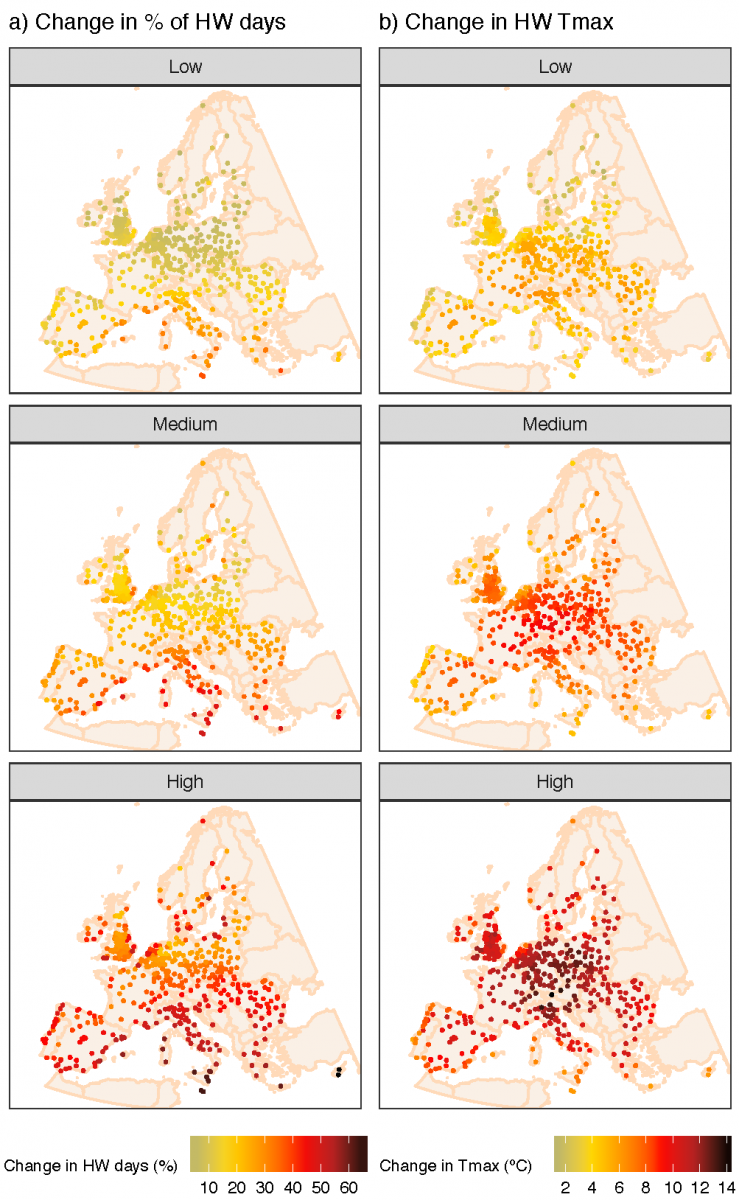What does climate change hold in store for European cities?
In the summer of 2003, an intense heat wave hit large chunks of Europe, causing tens of thousands of deaths and shrinking glaciers in the Alps by as much as 10%.
The event was, for many, a wake-up call: Research shows that such heat waves, not to mention floods and droughts, may become the new normal in much of Europe as climate change ramps up. A recent study explores how that new normal might affect people across the continent. The research draws on a wide range of computer simulations, or models, of climate change to gauge how rising temperatures could worsen extreme weather in 571 European cities during the second half of the 21st Century – from famous hubs like London and Paris to lesser-known towns like Cork, Ireland, and Kristiansand, Norway.
The results, published last week in Environmental Research Letters, were staggering: Under the worst-case scenarios for climate change, 72% of European cities could see temperatures increase during heat waves by as much as 10 degrees Celsius. Innsbruck, Austria, might experience spikes of 14 degrees Celsius. You can read coverage of the study from The Guardian, Quartz and other outlets here.
The paper’s findings come in the lead up to a major international event called the Cities and Climate Change Science Conference (CitiesIPCC), which will run from 5 to 7 March in Edmonton, Canada. The meeting will probe how climate change might affect cities around the world, and how towns and metropolises can address these challenges. One of the report’s authors, Richard Dawson, a professor at Newcastle University in the United Kingdom, sits on the Scientific Steering Committee for the conference. Future Earth sat down with Dawson and Selma Guerreiro, a research at Newcastle University and lead author of the new report, to discuss their findings and why city-dwellers shouldn’t feel overwhelmed.
Richard Dawson is a member of the Coordinating Committee of Future Earth’s Urban Knowledge-Action Network. You can learn more about Future Earth involvement in the CitiesIPCC conference here.

Daniel Strain: This study comes on the heels on what has been a difficult period for Europe – which has experienced pretty serious heat waves, flooding and other natural disasters. How is the continent already experiencing the sort of risks we can expect from a changing climate?
Richard Dawson: Over the last 10 to 15 years, there’s been an awful lot of extreme events. We had a couple of winters with successive storms hitting the UK and Ireland. That led to a large amount of flooding. This year, there were near record-breaking water levels in the centre of Paris.
Selma Guerreiro: We also had a very big heat wave in 2003 and in other parts of Europe and Russia in 2010, with lots of casualties. Portugal is suffering from a multi-year drought, which together with heat waves, caused widespread forest fires in June to October 2017 where several people died.
DS: A lot of studies have examined these threats to cities in Europe, but your work takes a much more comprehensive look, especially in examining information from a wide range of climate models. How does your research differ from some of these earlier studies?

SG: In terms of methods, we used all of the available climate models. Most studies tend to look at one or a subset of the climate models. And we wanted to look at these three hazards: the floods, the heat waves, the droughts. We wanted to look at them together in a consistent way so that we could compare them across different cities. Most studies on a continental scale only look at one hazard.
DS: And there are a lot of findings to pore through from your study. What stuck out for you?
SG: One of the things that was interesting – well, “interesting” is one way of putting it – was that for every scenario, even the more optimistic ones, all of the European cities saw increases in heat waves. That was both in maximum temperatures and in the number of days in a heat wave.
RD: Something that stuck out for me was the scale of the impacts. Under the higher-impact scenarios, these impacts far exceeded the magnitudes of projected impacts that have been reported elsewhere. That is because we we’re looking across the full range of available climate data, some of which were quite new.
SG: For example, in terms of drought, we are used to looking at the south of Europe, which really has a problem. But in the more pessimistic scenarios, we saw that even cities in the north of Europe would experience an increase in drought.
DS: For someone living in Innsbruck, for example, these results may seem overwhelming. What can citizens in these cities do to prepare for these risks?
RD: There are two things I would encourage people to do: One would be to reduce our greenhouse gas emissions. Real reductions in greenhouse gas emissions will make a significant difference when it comes to the increase in these risks. Although this is often considered a global challenge, everything counts and adds up.
I think there is a lot to be done to adapt cities so that they become more resilient to different climates. It takes time to change cities, and it takes time for buildings to change. Over the coming decades, there will be opportunities where buildings get repaired, redecorated or maybe pulled down and rebuilt entirely. These are opportunities to ensure that those changes consider water scarcity, flooding and heatwaves.
SG: And there are some adaptations that could be helpful for all of these risks. For example, increasing the green infrastructure within our cities provides benefits in addressing both heat waves and flooding.

DS: Are there good examples of cities, or their allies in research and beyond, who are already taking those first steps toward preparing for climate change?
SG: There are lots of cities looking at adaptation. In Copenhagen, for example, they had very intense rainfall over three events in the space of few years, and they are making a number of plans for future extreme events.
RD: Even in our home city of Newcastle, the City Council, university and a number of others made what they called the Newcastle Declaration on Blue and Green Infrastructure, which was to weave more green spaces into the city to help better manage extreme weather events.
The Urban Knowledge-Action Network’s ambition of bringing together scientists with policy-makers and practitioners is a big opportunity, but also a challenge. How do we make sure these communities talk to each other? How do we make sure we’re designing our cities based on the latest science, working with industry to ensure that building codes and regulations are sensitive to future climate?
DS: You also highlight in your paper that there is still a lot we don’t know about how climate change will affect these 571 cities, and how they can for those impacts. What are the next questions that the research community will have to explore?
SG: The research I’m doing now is looking at what is missing from this study, which is the intense rainfall associated with thunder storms, for example. In this paper, we talk about river flooding, but not in terms of flooding that occurs from intense rainfall events directly over cities. It’s an area of a lot of scientific development right now because our models are not able to reproduce such events yet.
RD: As an engineer, the focus of my research is on understanding the implications of environmental risks for the built environment and our infrastructure. This study has been a fantastic, high-level analysis, but we also need to make more detailed analyses routine. We need to build capacity and tools that enable planners, engineers and policy-makers to look at these risks, using the same sort of approach but at a spatial resolution that they can actually use form on-the-ground adaptation and action within their cities.
DS: Looking more broadly, what do you think the implications of this paper are for people who live in cities outside of Europe?
RD: It’s not unreasonable that such substantial changes might also be projected in other parts of the world. In many places, we’re already seeing really significant events and extremes. In Cape Town, for example, after successive years of low rainfall, the city has had to implement emergency plans to reduce water consumption, and is considering how to cope if reserves run completely dry, which is currently only a couple of months away, according to current forecasts.
DS: And many of those cities have a lot less research to draw on than do metropolises like London and Paris.
RD: One of the challenges that’s in mind at the moment is in other parts of the world outside of Europe, such as Asia, Latin America and Africa. Quite often there’s far less data that’s available, so we need to improve our knowledge and information base in a number of parts of the world if we’re to provide the same level of primary information and analysis.
DS: Looking forward to the CitiesIPCC conference next week, what would you want participants in that event to take away from this study?
RD: That conference is global in outlook, so not just Europe. But I hope the projections for these European cities help to provide recognition that there is still a lot to be done. We need to build on that and, hopefully, the conference will act as a broader call to arms, not just for European cities.
DS: There’s a lot to be worried about in this paper, but is there room for hope for people from these cities and many others around the world?
RD: We want to ring the alarm, but we don’t want to set people into panic. If you look at things that are going on now, we’ve got the UN Paris Agreement where we’re seeing the nations of the world commit to reducing greenhouse gases. The commitments that have been made are a good start, but they don’t go far enough. But we’ve got to be positive about that starting point. Within cities, there’s a lot that can be done. We can make little improvements that all add up. We don’t have to rip everything up and face a multibillion bill tomorrow.
SG: If people change their lifestyles, and if we start reducing our carbon footprint, there’s a lot we can do in terms of adaptation. And a lot of the measures we can do would make our cities better places to live and more resilient to all sorts of climate impacts.
Read more:
Guerreiro, Selma B.; Dawson, Richard J.; Kilsby, Chris; Lewis, Elizabeth; Ford, Alistair (2018). “Future heat-waves, droughts and floods in 571 European cities”. Environmental Research Letters. 13 (3): 034009. doi:10.1088/1748-9326/aaaad3. ISSN 1748-9326.
https://doi.org/10.1088/1748-9326/aaaad3
DATE
February 28, 2018AUTHOR
Daniel StrainRichard Dawson
Selma Guerreiro
SHARE WITH YOUR NETWORK
RELATED POSTS
Spotlight on LMICs – Tired of Breathing in Pollutants? Time for Better Fuel Economy and Vehicle Standards
Future Earth Taipei Holds 2024 Annual Symposium
Spotlight on LMICs – The Future’s Juggernaut: Positioning Research as Anchors for Environmental Health